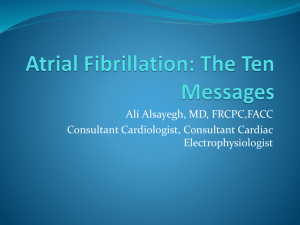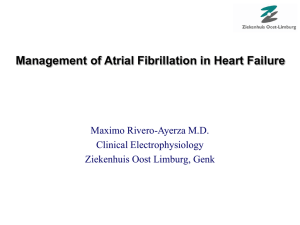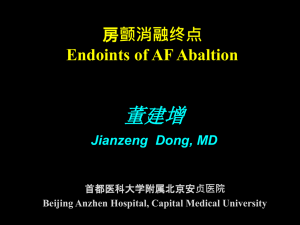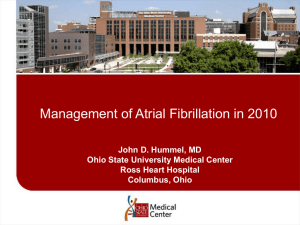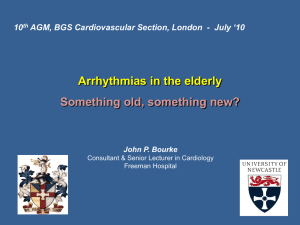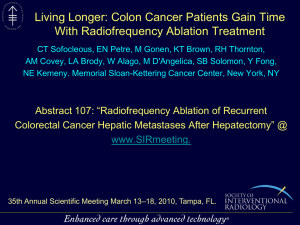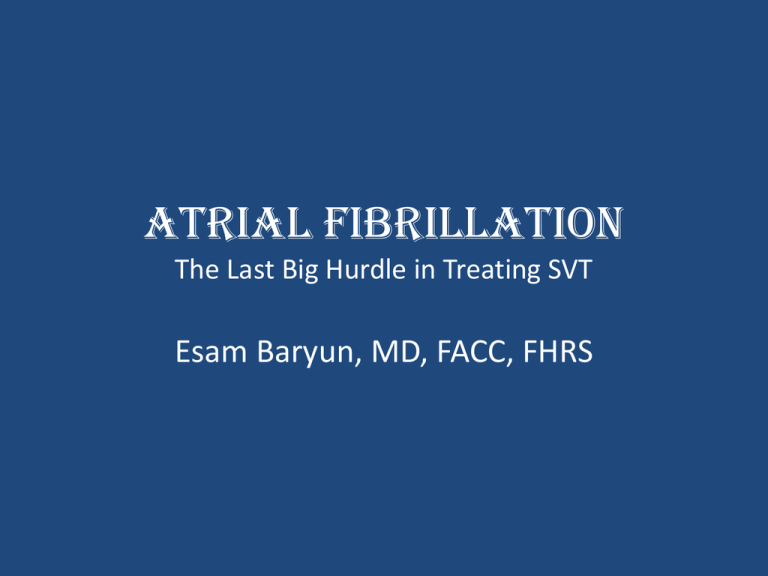
Atrial Fibrillation
The Last Big Hurdle in Treating SVT
Esam Baryun, MD, FACC, FHRS
Ever Felt Like This?
AF: an age related condition
Go et al JAMA 2001;285:2370-2375
AF: a growing problem
Doubling of patients with
AF from 1995 to 2030
Go et al JAMA 2001;285:2370-2375
Risk Factors
– Clinical:
• Non-modifiable: Age, Sex, Ethnicity, Genetic
• Modifiable: Htn, DM, CAD, Obesity, OSA, Tob
– Subclinical:
• LVH, Systolic/Diastolic dysfunction, LA size/function
• BNP, CRP
Obesity and AF Risk
Adjusted HR 1.5 with obesity, attributable to increased LA size
Wang et al, JAMA 2004; 292:2471
Causes of AF
• Anything that damages or stretches the atria:
– Htn, Aging
– Obstructive Sleep Apnea, Pulm Dz
– Ischemia, CHF, Myocarditis, Valvular Dz (MS, MR), CABG
– Thyrotoxicosis, Ethanol (Holiday Heart)
– Obesity BMI>30
– Accessory Pathway
– Genetics
Classifications of AF
• 1. Paroxysmal: “self terminating”
– Episodes of AF <7days.
• 2. Persistent
– Episodes of AF >7days
• 3. Permanent
– Rhythm control failed
• 4. “Lone”
– Describes any of the classifications above that occur in individuals
without structural cardiac or pulmonary disease.
NORMAL RHYTHM AF MORE AF ADVERSE OUTCOMES
• Once AF begins, there are multiple adverse outcomes
and therefore prevention is imperative.
• There are currently several potentially modifiable risk
factors for AF that may provide strategies for
population based interventions.
AF begets AF
• Electrical Remodeling: Reversible
– Tachy
–
Cellular Ca load
Decrease ARP and WCL
Triggered Activity
• Structural Remodeling: Not reversible
–
–
–
–
Fibrous tissue deposition Local conduction abnormality Reentry
This is sufficient for AF maintenance
Preventable but not reversible
Irreversibility may necessitate early intervention
• AF is a moving target: if SR maintenance is the intention,
earlier intervention may be particularly effective and
important.
Pts Converted to SR in 3 Mo of Onset Are More Likely to Remain in SR
Dittrich HC et al. Am J Cardiol. 1989;63:193-197
90
82%
<3-month duration of atrial fibrillation prior to cardioversion
>12-month duration of atrial fibrillation prior to cardioversion
Patients in sinus rhythm (%)
80
67%
70
60
50
36%
40
27%
30
20
10
0
1 month
P<.02
6 months
P<.07
The longer we wait to control rhythm the harder it is to
regain SR
AF causes Histologic Remodeling of Atria
as Early as 4 Months
Sinus Rhythm
Enlarged atrial cells
Severe myolysis
Glycogen accumulation
Reduction in Connexin
40 expression
AF
Gap Junctions
In heart cells the signal to contract is passed efficiently through gap junctions
Stroke and AF
• Framingham data: 4-5 fold increased risk
• Risk may be higher if silent multi-infarction cognitive impairment
included
• Chronic AF and paroxysmal AF carry same risk
• Stroke associated with AF: more severe with higher mortality
• Coumadin only prevents 65% of strokes.
Prevention of AF
• AF Genetics (Chromosome 4q25)
• Predictors (Who is at higher risk?)
– Sex, Age, BMI, Syst BP, PR interval, Murmur
– LA size, LV wall thickness
• Risk Prediction Models may help identify
patients for primary prevention.
– www.framinghamheartstudy.org/risk/index.html
AF Genetics
• Wolff described three brothers with AF in 1943.
• Increasing evidence of a heritable component of lone AF.
• Presence of AF in 1st degree relatives was associated with an
increased risk of developing AF.
• Positive F/H of AF in 1/3 of pts with lone AF indicating that
familial AF is more common than previously recognized.
Having at least 1 affected parent approximately doubled the risk of
predicted AF
Fox…Benjamin JAMA 2004;291:2851
Therapeutic Options
Management
• Medical therapy
– Rate control: AVN blockers
– Rhythm control: Anti-arrhythmics
– CVA prevention:
• Warfarin
• New antithrombotics
• LAA occlusion vs resection.
– PROTECT-AF (Watchman)
• Ablation
– Catheter Ablation:
• AF ablation: PVAI, Substrate modification
• AVN ablation and PPM
– Surgical Ablation
Other Anticoagulants
• Xa inhibitor
– Apixaban
• ARISTOTLE: Apixaban vs Warfarin
• AVERROES: Apixaban vs ASA in pts who can’t take coumadin
– Rivaroxaban – RECORD (Canada, Europe 9/08)
• Direct Thrombin Inhibitors:
– Dabigatran – PETRO phase III, RE-LY Study
• Very few drug-drug interaction (PPIs). No antidote.
• 110mg same CVA but less hge
• 150mg less CVA but same hge
– Ximelagatran – SPORTIF – as good as Warfarin but not FDA
approved due to Liver Toxicities
Dabigatran
• Direct Thrombin Inhibitor
• Approved by the FDA in October 19, 2010 for prevention of CVA in AF
• Dose:
– 150 mg twice daily
– If severe renal impairment (CrCl 15-30): 75 mg twice daily (dose Not studied in RELY!!)
• No specific antidote.
– Due to its short duration of effect drug discontinuation is usually sufficient to reverse
any excessive anticoagulant activity.
– In life-threatening bleeding: recombinant activated factor VII and prothrombin complex
concentrates can be considered.
Anti-arrhythmic Choice
New Antiarrhythmic Drugs
• Dronedarone
– Similar to Amiodarone but less lipophilic, no iodine, & half life
24hr.
– No significant organ toxicities
• Ranolazine (Na channel blocker)
– Alters the trans-cellular late Na current, indirectly prevents the
Ca overload, inhibits triggered activity
– Approved as anti-anginal.
• Vernakalant (K channel blocker)
– Atria selective
– Accepted for review by the FDA
Rate Control vs Rhythm Control
• AFFIRM (AF f/u Investigation of Rhythm Management) , NEJM 2002
• RACE (Rate Control vs. cardioversion for persistent AF) – NEJM 2002
• PIAF (Pharmacologic Intervention in Atrial Fibrillation) – Lancet 2000
• STAF (Strategies of Treatment of Atrial Fibrillation) – JACC 2003
• HOT CAFÉ ( How to Treat Chronic Atrial Fibrillation) – Chest 2004
Rate Control vs Rhythm Control
• Favor attempts to maintain SR:
–
–
–
–
–
First or infrequent episodes of persistent AF
Young active patient
Significant symptoms
Difficult rate control
Contraindication to long term warfarin
• Favor rate control:
– Asymptomatic sedentary elderly patient
– Contraindication to anti-arrhythmics or ablation
AFFIRM TRIAL
4060 patients
Persistent AF
Age >65, Mean 70
Other risk factors for stroke
Patients with contraindications for anticoagulant therapy were
excluded
Primary endpoint: all-cause mortality. Mean 3.5 years follow up.
For rhythm control group anticoagulant encouraged but could be
discontinued
AFFIRM TRIAL
• No difference in
mortality
• Similar incidence
of stroke: 1% per year in
each group
• Most strokes occurred in
pts off warfarin or
subtherapeutic INR
AFFIRM Investigators NEJM 2002;347:1825-33
WHAT AFFIRM DOES NOT TELL US
• Optimal management for:
– Pts with mod-severe disabling AF symptoms
– Younger pts with paroxysmal AF
• Outcome if better tools to maintain sinus rhythm
were available
• Long-term implications of rate vs rhythm control
(mean duration of follow-up only 3.5 years)
What DOES AFFIRM tell us?
• Do not stop coumadin in rhythm control pts.
• Elderly pts with asymptomatic persistent AF
are less likely to benefit from antiarrhythmics.
• Unfortunately we don’t have good
antiarrhythmic agents.
Limitations of the AFFIRM Study
•
May not be applicable to all pts with AF. Results cannot be generalized to :
– Younger patients
– Pts without other RF for stroke
– Paroxysmal AF
•
Pts with severe symptoms might have been considered unsuitable for a rate
control strategy and may not have been enrolled (Selection Bias).
•
In the rhythm control group, continuous anticoagulation was encouraged but
could be stopped at the physician’s discretion if SR had been maintained for at
least 4-12 weeks
– Most strokes occurred in pts in whom warfarin was stopped or were sub-therapeutic
•
Average follow-up was only 3.5 years and treatment of AF is a life-long process
•
A large proportion of pts in the rate control arm remained in SR. Does not reflect
typical outcome in pts with AF treated with rate control.
Rhythm Control
• In theory converting someone to NSR should:
– Improve cardiac hemodynamics
– Prevent LV dysfunction
– Maintain proper cardiac output
– Reduce risk of thromboembolism -> reduce risk of
death
AF Adversely Affects Qaulity of Life
Dorian P et al. J Am Coll Cardiol. 2000;36:1303-1309
120
100
80
Atrial fibrillation
92
88
85
78
68
60
54
70
71
76
81
68
59
Controls
40
20
0
General health
Post myocardial
infarction
Physical
function
Social function Mental health
Clinical Trials Showed the Survival Advantage of
Sinus Rhythm
• STAF: The Strategies for Treatment of AF study
– SR maintained in 30% of rhythm control patients
– Mortality:
• 2.5% per year in the rhythm control group
• 4.9% per year in rate control group
• Result was NOT statistically significant
•
•
•
•
Framingham Heart Study cohort
CHF-STAT
SOLVD
DIAMOND
AF increases mortality
• Framingham Heart Study cohort : Follow-up of the original
– AF was associated with a 1.5- to 1.9-fold mortality risk after
adjustment for preexisting cardiovascular conditions
• SOLVD: Studies of LV Dysfunction Prevention and Treatment Trial–
retrospective analysis
– Evaluated whether AF in pts with low EF was associated with higher
mortality.
– AF pts had greater:
• All-cause mortality (34% vs 23%, P < 0.001)
SR Decreases Mortality
• DIAMOND: The Danish Investigations of Arrhythmia and Mortality ON
Dofetilide study
– 3028 pts with severe CHF or recent MI
– Presence of SR was associated with a significant reduction in mortality (RR
0.44, 95% CI, 0.30-0.64, P < 0.0001)
• CHF-STAT : The CHF Survival Trial of Antiarrhythmic Therapy
– AF pts who converted to SR (n=16) had a lower mortality rate (P = 0.04) than
those who did not (n=35)
• AFFIRM Study Post Hoc Analyses: SR is a Predictor of Survival
– SR was associated with a lower risk of death (47% reduction)
– Anticoagulant use associated with a decreased risk of death (50% reduction)
Sustaining Sinus Rhythm Is Associated
With Decreased Mortality
Reduction in mortality (%)
60
50
44%
47%
40
30
20
10
0
DIAMOND
AFFIRM
The AFFIRM Investigators. Circulation. 2004;109:1509-1513;Circulation. 2001;104:292-296; Lancet. 2006;367:262-272.
CAN SINUS RHYTHM IMPROVE SURVIVAL?
Predictors of
Mortality in AFFIRM
Epstein et al, Circulation 2004;
109:1509
CABANA Trial
Ablation Vs Anti-Arrhythmic Drug Therapy for AF
• Designed to test the hypothesis that the treatment strategy of Afib
ablation will be superior to current therapy with either rate control or
rhythm control drugs for reducing total mortality.
• 3000 Pts randomized to Ablation or Pharmacologic Therapy
• CABANA Trial will disclose:
– The role of medical and non-pharmacologic therapies for AF
– Establish the cost and impact of therapy on quality of life
– Determine if AF is a modifiable risk factor for increased mortality.
AVN ablation and Pacemaker
Implantation
• Advantages:
– adequate rate control without drugs
– regularizes ventricular rate
• Disadvantages
– requires permanent pacemaker
– fibrillation continues: anticoagulation needed
– risk of torsade de pointes early after sudden rate decrease
– risk of hemodynamic deterioration from RV pacing
GN Kay et al Ablate and Pace J Intervent Card Electrophy 1998
Brignole et al Circulation 1998. Geelen P, et al. VF and sudden death after AVJ ablation. PACE 1997;20:343–8.
Jordaens L, et al. Sudden death and long term survival . Eur J Card EP 1993;21:102–9.
Gasparini M, et al. Long-term follow-up after AV ablation…PACE 2000;23:1925–9.
Ozcan C, et al. Long-term survival. NEJM 2001;344: 1043–51.
A New Idea Came Along
Haissguerre et al. NEJM1998;339:659-66
Mechanistic Approach to AF AblationSome Simplifications
• AF is predominantly driven by the LA.
• AF is predominantly driven by 2 mechanisms:
– I. Focal Rapid Firing from the PVs (Paroxysmal AF).
– II. Multiple Reentry Circuits around anatomical
obstacles (Chronic AFIB).
Ectopic Foci
Haissguerre et al. NEJM1998;339:659-66
Chen Circ1999;100:1879-86
AF ablation
Pulmonary Vein Antral Isolation
Pulmonary Vein Isolation
Going…
Going…
Haïssaguerre, M. et al., Circulation. 2000;102:2463–2465.
Gone !
Lt Inferior Pulmonary Vein
Side-by-Side Geometry
Electroanatomic Map & 3-D CT: Cranial View
Esophagus
Right PVs
Left PVs
LA Roof
LAA
ESI Nav-X 3-D Geometry
3-D CT via CardEP
(Cranial View)
AF ablation
• How is procedure performed?
– Out pt, 3-5hr, moderate-heavy sedation
– Discharged home next am
– Coumadin mandatory 6-8 weeks after
– Four vein sheaths:
• 2 RFV (Lasso, Ablation)
• LFV (ICE)
• RIJ (Duo-deca)
Visualization: Intracardiac Ultrasound
• Facilitate trans-septal access to LA
• Visual guidance of catheters at PV ostium
• Direct visualization of:
– PV ostial size
– Anatomic abnormalities
– Pericardial effusion
– Thrombus
Left Atrial Mapping and Catheter Ablation
Visualization: Intracardiac Ultrasound
Tenting of the
intra-atrial
septum during
transeptal
catheterization
Transeptal Access to LA
AcuNav 10 Fr Phased Array Diagnostic Ultrasound Catheter (by Acuson)
Left Atrial Mapping and Catheter Ablation
Visualization : Intracardiac Ultrasound
Optimizing Catheter Placement at PV Os
Trans-septal Puncture with LA entry
Intracardiac Echo
Tenting of Interatrial septum
Esophagus posterior to LA
Lasso on Lt Inf PV
Lasso on Lt Sup PV
So why ablate?
• Our best drugs are:
– Only moderately effective (30-50%)
– Have side effects/toxicities
• Many patients despite adequate rate control remain
symptomatic in AF
• Sustaining SR may be associated with decreased
mortality
AF ablation
Pappone, JACC, 2003
Risks vs Benefits
Potential benefits
Potential harm
• Symptomatic benefit
• Stroke
• No need for AADs
• LA flutters
• Thromboembolic
benefit
• Tamponade
• TE fistula
• Mortality benefit?
• PV stenosis
Post Ablation Care
• Early AF recurrence (not uncommon)
– 20-50% of patients
– More than half will resolve within 3 mos
– Antiarrhythmic drugs usually continued for first 2-6 months
• Atrial tachycardias post ablation
• Anticoagulation
– High risk of CVA in first month post RFA
• Redo procedures in 20% of pts (after 3 mo)
AF case 1
• 67y old female, school teacher
• Recurrent symptomatic AF with RVR
– Admitted to hospital several times, twice in 10/08
– Tachypalpitations several times a week
• Failed amiodarone and sotalol
• AFib RFA 11/08
• Post RFA:
–
–
–
–
One AF episode 2 days after ablation (blanking period)
No tachypalpitations since then
A 2 wk MCOT 2 & 6 months later shows no AF
Off amiodarone and coumadin
MCOT 2mo after ablatioin
AF case 2
•
•
•
•
•
Middle age female, Nurse
Paroxysmal AF with RVR, once/1-2months
Failed anti-arrhythmics
A fib ablation in 12/08
Follow up:
– No episodes since ablation
– MCOT 2/16-2/24 showed 0% AF
– Tikosyn was stopped four months after ablation
Case 3
• 50y old female
• Frequent tachypalpitations, with significant
symptoms
• Propafenone helped a little
– Dose increased but still significantly symptomatic
– Palpitations occur if one dose is delayed 2hr
– Max dose of AA caused metallic taste
Baseline MCOT
Higher dose only decreased episodes
Propafenone 225mg
Propafenone 150mg
• A fib ablation 3/09
• Follow up:
– No more palpitations immediately after ablation
– 2 month:
• No palpitations even when misses AA dose
• Feels great and more energetic
– 3 months:
• Propafenone was discontinued three months after ablation
• Repeat MCOT showed no AF
Case 4
• 51y old man with symptomatic persistent AF
• On amiodarone for >6 mo
• Amiodarone stopped given his age, and 2 mo
later started on tikosyn
• AF ablation 3/09
MCOT 2 months post RFA
Remains AF free 5 months after
Case 5
•
•
•
•
66y old female
Persistent symptomatic AF for >1 year
Failed multiple AA therapy
Success rate with ablation less than
paroxysmal AF
AF Ablation on 5.28.09
AF burden decreased gradually weeks after PVAI
Case 6
60 y old man with persistent AF. Amiodarone started 7.28.09.
DC CV 9.3.09. AF ablation 11.16.09.
Case 7
65y old man failed two anti-arrhythmics
AF ablation in 5.09
MCOT 4 months later
Propafenone was discontinued
Conclusion
• These advances may yet tip the balance back
in favor of a rhythm control strategy.
• RFA of the PVs has been successful in longterm maintenance of SR, representing a
curative strategy that eliminated the need for
pharmacotherapy for AF in drug-refractory
patients.


